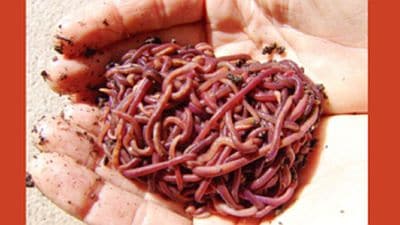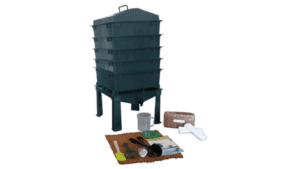(Image above: Eisenia fetida – Red worm, Red Wriggler)
Vermiculture
The Magic of Worm Composting
with Professor Vladimir Excelsior Wormsley II
From presentation by Richard Bienvenu, Master Gardener of Greater New Orleans
By sheer numbers alone, earthworms have a tremendous impact on local ecosystems (though not all of it is good, researchers have recently learned). There are more than 3,000 species of earthworm on the planet, and they range in average sizes from.4 inches (1 centimeter) to 9 feet (2.7 meters) in length, although outsized monsters are routinely reported around the world. In a single hectare (2.47 acres) of land, you may find 500,000 to 2 million individual worms. You may further find that the total wet biomass of all these worms equals 10 times the total weight of all the animals living aboveground on that same plot of land.
In some northern regions of North America, there are no earthworm species around just a few hundred years ago. That’s because during the last ice age, most earthworm species native to North America died out due to the change in climate. The earthworms you’ll find today in abundance in the temperate woodlands and forests of northern North America are relatively recent immigrants from Europe and Asia, who hitched rides in the soil attached to plants imported to North America in the 19th and 20th centuries. In this clime, they’ve flourished and spread even farther, due to humans who purchase them as fish bait and often release them into the wild or inadvertently give them long distance rides attached to the tread of car tires.
Earthworms typically fall into one of three categories based on where in the soil they live. If you took a spade and dug down a couple feet into soil that’s covered with a top layer of dead leaves in just about any temperate woodland in North America or Europe, you’d likely encounter all three classifications of earthworms.
-
- Epigeic class of earthworms (epi means “above” and geic derives from “Gaia” or “Earth”). These worms play a big role in decomposing leaves and other organic matter that falls to the woodland floor simply by eating it. Redworms, also called manure worms, are among the comparatively small epigeic earthworms, and they’re commonly sold for use in compost piles.
- Endogeic earthworms generally move parallel to the surface, leaving horizontal burrows and eating organic material found only beneath the ground, like dead plant roots.
- Deep-dwelling anecic class is the most familiar types of earthworms. Their burrows are strong enough that they tend to be permanent and can reach several feet beneath the surface. They too feed on leaf litter, but anecic worms pull whole leaves down into their burrows where they feed at their leisure. In a single night, Lumbricus terrestris — the common European earthworm, known in the U.S. as the night crawler — can travel as far as 62 feet (19 meters) along the soil surface in search of food.
It’s essentially an eating (and defecating) machine. A mouth at the front end leads to long tube where the organic matter and dirt from the worm’s diet pass through the other end. Organic matter is pushed into the crop, where food is stored, and then into a gizzard, where tiny pebbles previously eaten grind food for further digestion. They depend on bacteria, fungi, molds, nematodes and protozoa to break down food.
The intestinal walls lined with blood vessels effused with blood by one of the aortic arches, the earthworm’s five hearts. microbes living in the worm may attach to the dirt and remaining organic material, deposited as worm feces, called castings.

An earthworm lacks any kind of lungs, instead of inhaling and exhaling like us, the exchange of these gases in and out of the earthworm takes place passively through the skin. An earthworm can even survive submerged in water if it contains enough available oxygen. An earthworm’s skin must always be moist. Without enough moisture at the skin, the gas exchange can’t occur, and the worm can’t breathe. If you’ve ever seen a dead, desiccated earthworm curled up on a sidewalk on a warm day, you’ve likely met an earthworm that suffocated to death. Need to avoid heat necessitates staying out of the sun, earthworms have evolved a means of determining if the sun’s out. They don’t have eyes, but they can detect light. Specialized photosensitive cells on the earthworm’s skin convert light into electrical impulses that the worm senses and reacts to, moving back below ground or under the cover of plant matter.
Earthworms are simultaneous hermaphrodites, meaning worms have both male and female reproductive organs. During sexual intercourse among earthworms, both sets of sex organs are used by both worms. Vermicomposters, report that their earthworm populations typically double every 60 to 90 days. Two worms line up against one another facing opposite directions. In this position, excreting mucous, a slime tube forms around both bodies, each send sperm into the other’s receptacle. The wide band around the worm, clitellum, moves forward toward the mouth and collects the worms’ eggs in the mucous and passes where the sperm is kept and the eggs, about 20, are fertilized, deposited into the soil and hatch from 7-10 days.
Although earthworms are hermaphroditic, they must still copulate in order to mix their gametes. Earthworms are also capable of regrowing amputated segments of their bodies, From the time it emerges from its cocoon to the day it dies, an earthworm’s life expectancy can vary widely, depending on the species. The night crawler has an average life span between six to nine years and has been reported to live up to 20 years. Red worms typically live between two and five years. Gray worms, which spend their entire lives beneath the soil surface, tend to live between 1.25 and 2.6 years on average.
(Images below: [left] Fancy worm composter; [right] Plastic container composter)

They eat 30% of bodyweight a day. Every 3 months expect the red wigglers to double in population.
Shredded newspaper and junk mail (not plastic coated) they will eat. Even cardboard soaked in water, paper egg cartons too.

(Image above: Easy Worm Compost Starter)
Dry leaves can be put on top layer – but not bay, eucalyptus, magnolia, pine, fir or cedar. The worms will die!
No salty foods, citrus peels, oils, meat, dairy.
Run out of food? Get coffee grounds from your local coffee shop! Or just give them some junk mail!

By Karen Blackburn



